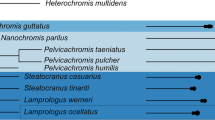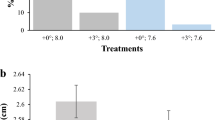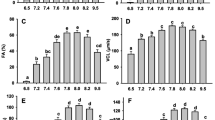Abstract
Acute and long-term temperature changes caused by global warming could lead to severe ecological and physiological consequences for aquatic organisms. This might be reflected in a higher mortality rate or a reduced hatching success but elevated temperatures might also lead to accelerated growth and egg development due to higher metabolic rates. Thermal conditions could also act on male gamete function that is known to be under strong sexual selection especially in mating systems where sperm competition frequently occurs. The three-spined stickleback (Gasterosteus aculeatus) is an externally fertilizing fish species. Males are sperm limited over the course of one breeding season and the risk of sperm competition is known to be high. To study the impact of ecologically relevant water temperatures in relation to different sperm numbers on reproductive performance standardized in vitro fertilization experiments were conducted, using two different immediate temperature changes (15 and 25 °C) as all test individuals were held under the same conditions prior to the experiments. The results revealed that fertilization success differed significantly when using different sperm numbers in different water temperatures. At higher temperatures a lower number of sperm was sufficient to fertilize 50 % of the eggs. However, with increasing sperm number fertilization success saturated at 75 % in the 25 °C treatment but at about 90 % in the 15 °C treatment. A further experiment dealt with sperm swimming ability at different temperatures (5, 15 and 25 °C), showing that both sperm velocity and linearity significantly increased whereas the percentage of motile sperm decreased at higher temperatures, suggesting that under these conditions sperm might reach an unfertilized egg more rapidly but live shorter. The observed results stress the role of current and future levels of naturally occurring ambient water temperatures as an important environmental factor influencing fitness related traits.


Similar content being viewed by others
References
Adriaenssens B, van Damme R, Seebacher F, Wilson RS (2012) Sex cells in changing environments: can organisms adjust the physiological function of gametes to different temperatures? Glob Change Biol 18:1797–1803
Alavi SMH, Cosson J (2005) Sperm motility in fishes. I. Effects of temperature and pH: a review. Cell Biol Int 29:101–110
Albright R, Mason B (2013) Projected near-future levels of temperature and pCO2 reduce coral fertilization success. PLoS ONE 8:e56468
Allen JRM, Wootton RJ (1982) The effect of ration and temperature on the growth of the three-spined stickleback, Gasterosteus aculeatus L. J Fish Biol 20:409–422
Bakker TCM, Milinski M (1993) The advantages of being red: sexual selection in the stickleback. Mar Behav Physiol 23:287–300
Bakker TCM, Zbinden M, Frommen JG, Weiss A, Largiadèr CR (2006) Slow fertilization of stickleback eggs: the result of sexual conflict? BMC Ecol 6:7
Bakker TCM, Hollmann M, Mehlis M, Zbinden M (2014) Functional variation of sperm morphology in sticklebacks. Behav Ecol Sociobiol 68:617–627
Beirão J, Soares F, Herráez MP, Dinis MT, Cabrita E (2011) Changes in Solea senegalensis sperm quality throughout the year. Anim Reprod Sci 126:122–129
Blahm TH, Snyder GR (1975) Effect of increased water temperatures on survival of adult threespine stickleback and juvenile yellow perch in the Columbia River. Northwest Sci 49:267–270
Bolger T, Connolly PL (1989) The selection of suitable indices for the measurement and analysis of fish condition. J Fish Biol 34:171–182
Bombardelli RA, Sanches EA, Baggio DM, Sykora RM, de Souza BE, Tessaro L, Piana PA (2013) Effects of the spermatozoa: oocyte ratio, water volume and water temperature on artificial fertilization and sperm activation of cascudo-preto. Rev Bras Zootec 42:1–6
Borg B (1982) Seasonal effects of photoperiod and temperature on spermatogenesis and male secondary sexual characters in the three-spined stickleback, Gasterosteus aculeatus. Can J Zool 60:3377–3386
Borg B, Bornestaf C, Hellqvist A, Schmitz M, Mayer I (2004) Mechanisms in the photoperiodic control of reproduction in the stickleback. Behaviour 141:1521–1530
Breckels RD, Neff BD (2013) The effects of elevated temperature on the sexual traits, immunology and survivorship of a tropical ectotherm. J Exp Biol 216:2658–2664
Caldwell GS, Fitzer S, Gillespie CS, Pickavance G, Turnbull E, Bentley MG (2011) Ocean acidification takes sperm back in time. Invertebr Reprod Dev 55:217–221
Cheung WWL, Watson R, Pauly D (2013) Signature of ocean warming in global fisheries catch. Nature 497:365–368
Cingi S, Keinänen M, Vuorinen PJ (2010) Elevated water temperature impairs fertilization and embryonic development of whitefish Coregonus lavaretus. J Fish Biol 76:502–521
Crivelli AJ, Britton RH (1987) Life history adaptations of Gasterosteus aculeatus in a Mediterranean wetland. Environ Biol Fish 18:109–125
de Fraipont M, FitzGerald GJ, Guderley H (1993) Age-related differences in reproductive tactics in the three-spined stickleback, Gasterosteus aculeatus. Anim Behav 46:961–968
de Vlaming V, Grossman GD, Chapman F (1982) On the use of the gonosomatic index. Comp Biochem Physiol 73:31–39
Elofsson H, Van Look KJW, Sundell K, Sundh H, Borg B (2006) Stickleback sperm saved by salt in ovarian fluid. J Exp Biol 209:4230–4237
Fauvel C, Savoye O, Dreanno C, Cosson J, Suquet M (1999) Characteristics of sperm of captive seabass in relation to its fertilization potential. J Fish Biol 54:356–369
Frommen JG (2001) Verbreitung des Dreistachligen Stichlings (Gasterosteus aculeatus L.) im Bonner Raum und Versuche zur Schwarmwahl. Diploma thesis: University of Bonn
Grazer VM, Martin OY (2012) Investigating climate change and reproduction: experimental tools from evolutionary biology. Biology 1:411–438
Guderley HE (1994) Physiological ecology and evolution of the threespine stickleback. In: Bell MA, Foster SA (eds) The evolutionary biology of the threespine stickleback. Oxford University Press, Oxford, pp 1–27
Hopkins K, Moss B, Gill A (2011) Increased ambient temperature alters the parental care behaviour and reproductive success of the three-spined stickleback (Gasterosteus aculeatus). Environ Biol Fishes 90:121–129
Hughes L (2000) Biological consequences of global warming: is the signal already apparent? Trends Ecol Evol 15:56–61
IPCC (2007) Climate change 2007: synthesis report. In: Contribution of working groups I, II and III to the fourth assessment report of the intergovernmental panel on climate change. Geneva, Switzerland
IPCC (2013) Climate change 2013: the physical science basis. In: Contribution of working group I to the fifth assessment report of the intergovernmental panel on climate change. Stockholm, Sweden
Islam MS, Akhter T (2011) Tale of fish sperm and factors affecting sperm motility: a review. Adv Life Sci 1:11–19
Jeppesen E, Meerhoff M, Holmgren K, González-Bergonzoni I, Teixeira-de Mello F, Declerck SAJ, De Meester L, Søndergaard M, Lauridsen TL, Bjerring R, Conde-Porcuna JM, Mazzeo N, Iglesias C, Reizenstein M, Malmquist HJ, Liu Z, Balayla D, Lazzaro X (2010) Impacts of climate warming on lake fish community structure and potential effects on ecosystem function. Hydrobiologia 646:73–90
Knowlton N (2001) The future of coral reefs. Proc Natl Acad Sci USA 98:5419–5425
Lahnsteiner F (2011) Spermatozoa of the teleost fish Perca fluviatilis (perch) have the ability to swim for more than two hours in saline solutions. Aquaculture 314:221–224
Lahnsteiner F (2012) Thermotolerance of brown trout, Salmo trutta, gametes and embryos to increased water temperatures. J Appl Ichthyol 28:745–751
Lahnsteiner F, Caberlotto S (2012) Motility of gilthead seabream Sparus aurata spermatozoa and its relation to temperature, energy metabolism and oxidative stress. Aquaculture 370:76–83
Lahnsteiner F, Mansour N (2012) The effect of temperature on sperm motility and enzymatic activity in brown trout Salmo trutta, burbot Lota lota and grayling Thymallus thymallus. J Fish Biol 81:197–209
Largiadèr CR, Fries V, Bakker TCM (2001) Genetic analysis of sneaking and egg-thievery in a natural population of the three-spined stickleback (Gasterosteus aculeatus L.). Heredity 86:459–468
Lee W-S, Monaghan P, Metcalfe N (2012) The pattern of early growth trajectories affects adult breeding performance. Ecology 93:902–912
Levitan DR (2000) Sperm velocity and longevity trade off each other and influence fertilization in the sea urchin Lytechinus variegatus. Proc R Soc Lond B 267:531–534
Levitus S, Antonov JI, Boyer TP, Stephens C (2000) Warming of the world ocean. Science 287:2225–2229
Macnab V, Barber I (2012) Some (worms) like it hot: fish parasites grow faster in warmer water, and alter host thermal preferences. Glob Change Biol 18:1540–1548
Mehlis M, Bakker TCM, Engqvist L, Frommen JG (2010) To eat or not to eat: egg-based assessment of paternity triggers fine-tuned decisions about filial cannibalism. Proc R Soc Lond B 277:2627–2635
Mehlis M, Frommen JG, Rahn AK, Bakker TCM (2012) Inbreeding in sticklebacks (Gasterosteus aculeatus L.): effects on testis and sperm traits. Biol J Linn Soc 107:510–520
Mehlis M, Hilke LK, Bakker TCM (2013) Attractive males have faster sperm in three-spined sticklebacks Gasterosteus aculeatus. Curr Zool 59:761–768
Nissling A, Johansson U, Jacobsson M (2006) Effects of salinity and temperature conditions on the reproductive success of turbot (Scophthalmus maximus) in the Baltic Sea. Fish Res 80:230–238
Parker GA (1982) Why are there so many tiny sperm? Sperm competition and the maintenance of two sexes. J Theor Biol 96:281–294
Parker GA (1990) Sperm competition games: raffles and roles. Proc R Soc Lond B 242:120–126
Parmesan C (2006) Ecological and evolutionary responses to recent climate change. Annu Rev Ecol Evol Syst 37:637–669
Pizzari T, Parker GA (2009) Sperm competition and sperm phenotype. In: Birkhead TR, Hosken DJ, Pitnick S (eds) Sperm biology: an evolutionary perspective. Academic Press, San Diego, pp 207–245
Poizat G, Rosecchi E, Crivelli AJ (2002) Life-history variation within a three-spined stickleback population in the Camargue. J Fish Biol 60:1296–1307
Præbel K, Christiansen JS, Kettunen Præbel A, Fevolden S-E (2013) Thermohaline tolerance and embryonic development in capelin eggs (Mallotus villosus) from the Northeast Atlantic Ocean. Environ Biol Fishes 96:753–761
Purchase CF, Butts IAE, Alonso-Fernandez A, Trippel EA (2010) Thermal reaction norms in sperm performance of Atlantic cod (Gadus morhua). Can J Fish Aquat Sci 67:498–510
Rick IP, Bakker TCM (2008) UV wavelengths make female three-spined sticklebacks (Gasterosteus aculeatus) more attractive for males. Behav Ecol Sociobiol 62:439–445
Rick IP, Modarressie R, Bakker TCM (2006) UV wavelengths affect female mate choice in three-spined sticklebacks. Anim Behav 71:307–313
Rick IP, Mehlis M, Eßer E, Bakker TCM (2014) The influence of ambient ultraviolet light on sperm quality and sexual ornamentation in three-spined sticklebacks (Gasterosteus aculeatus). Oecologia 174:393–402
Romagosa E, Souza BE, Sanches EA, Baggio DM, Bombardelli RA (2010) Sperm motility of Prochilodus lineatus in relation to dilution rate and temperature of the activating medium. J Appl Ichthyol 26:678–681
Rurangwa E, Roelants I, Huyskens G, Ebrahimi M, Kime DE, Ollevier F (1998) The minimum effective spermatozoa: egg ratio for artificial insemination and the effects of mercury on sperm motility and fertilization ability in Clarias gariepinus. J Fish Biol 53:402–413
Schrier-Uijl AP, Veraart AJ, Leffelaar PA, Berendse F, Veenendaal EM (2011) Release of CO2 and CH4 from lakes and drainage ditches in temperate wetlands. Biogeochemistry 102:265–279
Swarup H (1958) Stages in the development of the stickleback Gasterosteus aculeatus (L.). J Embryol Exp Morphol 6:373–383
Vezzulli L, Colwell RR, Pruzzo C (2013) Ocean warming and spread of pathogenic vibrios in the aquatic environment. Microb Ecol 65:817–825
Williot P, Kopeika EF, Goncharov BF (2000) Influence of testis state, temperature and delay in semen collection on spermatozoa motility in the cultured Siberian sturgeon (Acipenser baeri Brandt). Aquaculture 189:53–61
Wootton RJ (1976) The biology of the sticklebacks. Academic Press, London
Wootton RJ (1984) A functional biology of sticklebacks. Croom Helm, London
Xenopoulos MA, Lodge DM, Alcamo J, Marker M, Schulze K (2005) Scenarios of freshwater fish extinctions from climate change and water withdrawal. Glob Change Biol 11:1557–1564
Zbinden M, Largiadèr CR, Bakker TCM (2001) Sperm allocation in the three-spined stickleback. J Fish Biol 59:1287–1297
Zbinden M, Largiadèr CR, Bakker TCM (2004) Body size of virtual rivals affects ejaculate size in sticklebacks. Behav Ecol 15:137–140
Acknowledgments
We are grateful to the “Bakker”-research-group for discussion and Jan Hottentot for catching the sticklebacks. Ingolf P. Rick, Meike Hiermes, Joachim G. Frommen and anonymous referees gave meaningful comments on an earlier draft of this manuscript. Lukas K. Hilke is acknowledged for assistance in analyzing sperm motility. This research was funded by the Deutsche Forschungsgemeinschaft (DFG) (BA 2885/4-1).
Author information
Authors and Affiliations
Corresponding author
Electronic supplementary material
Below is the link to the electronic supplementary material.
Rights and permissions
About this article
Cite this article
Mehlis, M., Bakker, T.C.M. The influence of ambient water temperature on sperm performance and fertilization success in three-spined sticklebacks (Gasterosteus aculeatus). Evol Ecol 28, 655–667 (2014). https://doi.org/10.1007/s10682-014-9707-x
Received:
Accepted:
Published:
Issue Date:
DOI: https://doi.org/10.1007/s10682-014-9707-x




